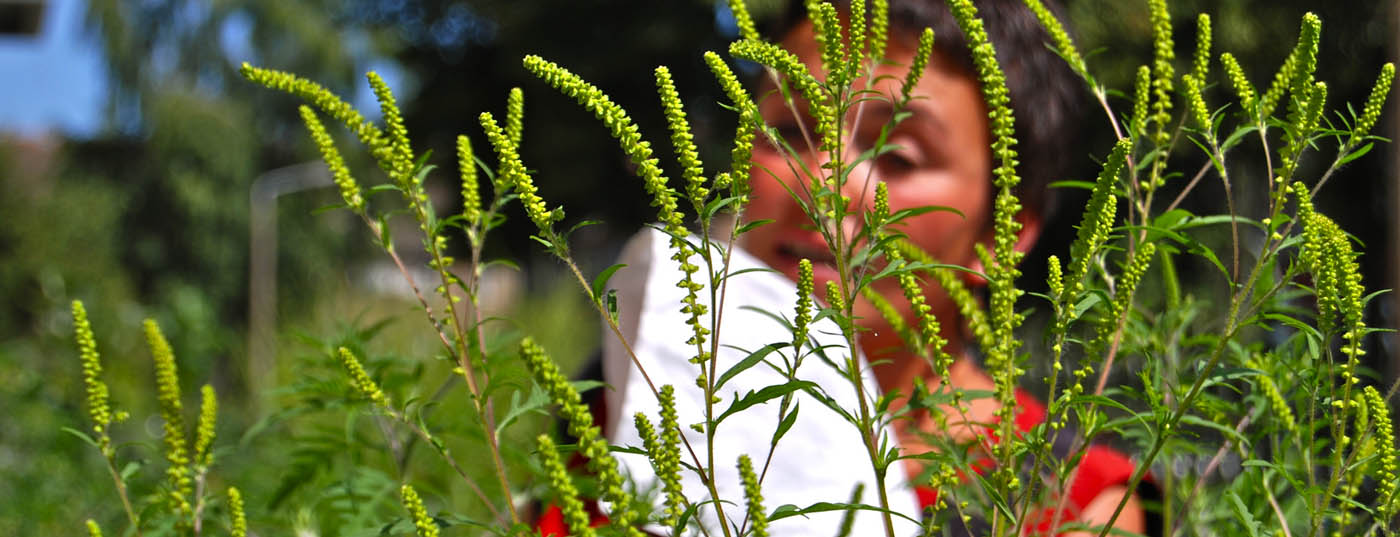If neither exposure prophylaxis nor symptom-oriented medication can provide sufficient relief of allergic symptoms, specific immunotherapy (SIT) is indicated. A distinction is made between subcutaneous and sublingual SIT. Contraindications must be observed and patients must be monitored during the procedure. Severe systemic anaphylaxis is very rare and usually preventable; in contrast, local reactions are frequently described.
In Switzerland, about 15-20% of the population suffers from a pollen allergy, 5-8% from a house dust mite allergy and 3-4% from a bee/wasp venom allergy (hymenoptera venom allergy). If neither exposure prophylaxis nor symptom-oriented medication can achieve sufficient relief of allergic symptoms, specific immunotherapy (SIT) is indicated as the only causative treatment. SIT can achieve tolerance to allergens as well as prevent the development of new sensitization and bronchial asthma. Subcutaneous and sublingual preparations are available for performing SIT.
Mechanism of action of SIT
For subcutaneous specific immunotherapy (SCIT), in contrast to sublingual immunotherapy (SLIT), the mechanism of action has been largely elucidated. There is activation of T-regulatory cells under the influence of interleukin(IL)-10 and -12 [1]. This decreases the release of IL-5, -4, and -13 and increases the release of interferon-γ, Il-10, and transforming growth factor-β (TGF-β), which reduces IgE production by B lymphocytes and the number of eosinophilic granulocytes. Allergen-specific, “blocking” IgG antibodies are produced that inhibit antigen presentation, T-cell proliferation, and mast cell degranulation [2,3].
Allergen extracts
Native and chemically modified extracts (allergens) are used for SCIT. These are usually bound to adjuvants such as aluminum hydroxide. The adjuvants enhance the immunological effect of the allergen extracts. Unmodified allergens and chemically modified extracts are also available for SLIT as tablets or aqueous solutions. Due to different composition and widely varying allergen activity, all extracts have the disadvantage of limited standardizability and potential triggering of allergic side effects.
Effectiveness
Because of different study results, each extract must be evaluated on its own merits. A 2007 Cochrane Review demonstrated a significant reduction in medication use and symptoms when treating rhinoconjunctivitis allergica (RCA) with SCIT [4]. This was also confirmed in patients with allergic bronchial asthma (ABA). Patients with rhinoconjunctivitis and asthma benefit from SCIT at an early age. SCIT in atopic dermatitis or food allergies cannot be recommended at present. SCIT achieves protection from severe anaphylactic reactions due to hymenopteran venoms in over 90%.
Regarding the efficacy of SLIT with grass pollen, several studies have demonstrated a reduction in symptoms and medication use in patients with RCA. Studies in children with rhinoconjunctivitis allergica showed comparable effects of SLIT as in adults. SCIT is very likely to prevent neusensitization and bronchial asthma. SLIT offers the advantage over SCIT that the risk of severe systemic reactions is lower [5].
Indications and contraindications
SIT is indicated in patients with seasonal and perennial RCA (pollen, house dust mites, possibly animal epithelia) and ABA whose symptoms cannot be controlled despite drug therapy with e.g. topical steroids as well as topical and systemic antihistamines and exposure prophylactic measures or in whom there are contraindications or aversions to the use of corresponding drugs [6,7]. SIT is also indicated for the treatment of hymenoptera venom allergy in patients with severe general symptoms after hymenoptera sting [1]. If SCIT is not an option in pollen-sensitized patients with RCA, SLIT is indicated. SLIT is not an alternative to SCIT for dust mite, animal, mold, or hymenopteran venom allergy. SIT should not be used in children until they are five years of age or older for compliance reasons.
Contraindications to SIT include uncontrolled or persistent severe bronchial asthma, autoimmune or neoplastic disease, and poor compliance (dropout rate for SLIT up to >90%). Additional contraindications are inflammation of the oral and pharyngeal mucosa in the case of SLIT, and the use of beta-blockers in the case of SCIT. In principle, all contraindications are relative and must be discussed on a case-by-case basis.
In pregnancy, the risk-benefit ratio of SIT must be weighed very carefully, especially in the case of hymenoptera venom allergy. If avoidable and in the absence of a vital threatening indication, SIT should not be started during pregnancy. If a patient becomes pregnant while on SIT and the maximum dose of SIT has been reached, therapy may be continued. Dose increase must not be made during pregnancy.
Safety and risks
Despite its potentially severe, rare allergic side effects, SCIT currently represents the gold standard in the treatment of patients with RCA and ABA. Early detection of developing anaphylaxis is important. The physician administering SIT and his or her staff must be skilled in the management of anaphylactic reactions. All patients must be monitored for at least 30 minutes after SIT [8]. Fortunately, severe systemic anaphylaxis is very rare (<0.01%) and usually preventable if appropriate precautions are taken.
Local reactions such as burning and itching of the oral and pharyngeal mucosa with SLIT and redness and swelling at the injection site with SCIT are frequently described. In case of strong local reaction (>10 cm) at the injection site, the dose should not be increased at the next injection. be reduced. An antihistamine may be administered before the next injection.
The causes of adverse effects should be elicited and avoided as much as possible during the next injection. Risk factors for adverse effects during SIT include severe physical or psychological stress before or after SIT, alcohol intake, uncontrolled, unstable bronchial asthma, infections, or overdose of the allergen extract [9]. All patients treated with SIT must be equipped with an emergency kit (2 tablets of an antihistamine, 2 tablets Spiricort® 50 mg, possibly EpiPen®).
Practical implementation of a SIT
Before SIT, the patient must be informed about the therapy and the discussion must be documented. In any practice where SIT is performed, the possibility of acute treatment of an anaphylactic reaction must be available (especially with epinephrine as the first-line agent) and staff must be regularly trained in this regard. It is recommended to start SIT only after prior allergological clarification by a specialist in allergology or a physician experienced in allergology. Treatment can then be continued by the supervising physician. If allergic symptoms occur for the first time, a second pollen season should be waited for before the indication for SIT is given.
Before starting SIT, the clinical relevance of the sensitizations found is checked. Sensitization that does not correlate clinically with symptoms is not an indication to start SIT. Conversely, the prerequisite for starting SIT is evidence of IgE-mediated type I sensitization associated with clinical symptoms (demonstrated in skin and/or in vitro tests). If there is any doubt regarding clinical symptoms, provocation testing is indicated.
In SCIT, allergens should be kept to a minimum in the extract, and seasonal and perennial allergens should never be mixed. Before each injection, infections, acute allergic symptoms or the use of contraindicated medications must be ruled out. Preparation and dose as well as patient identity are compared with the labeling of the allergen extract to exclude mix-ups. In patients with ABA, peak flow is measured half an hour before and half an hour after injection [10].
The treating physician injects SCIT strictly subcutaneously about a hand’s width above the elbow on the upper arm extensor side. Finally, the dose, injection site, and any local/systemic reactions that occur are documented. In the increase phase, the periods between two injections are 1-2 weeks. Once the maximum dose is reached, the intervals can be extended to 1-2 months. If the interval between two injection intervals is more than two months, consultation with the allergist may be necessary. For SCIT with seasonal aeroallergens, the increase occurs preseasonally; once the maximum dose is reached, SCIT can be continued year-round or preseasonally for a total of three to five years. Depending on the seasonal allergic symptoms, in case of cosaisonal SCIT the dose has to be reduced during the relevant pollen season [10].
When administering multiple allergen extracts in the same session, it is recommended to maintain a 15-minute interval between injections. In centers, SIT can also be performed in a cluster or rush procedure. Especially SCIT in severe hymenoptera venom allergies is readily initiated under steady-state conditions using the ultra-rush method. Subsequently, the maintenance dose is administered at one-month intervals. In patients with severe sting reactions, elevated serum tryptase >11.4 µg/l and/or mastocytosis, lifelong SCIT is recommended.
SLIT with inhalation allergens can be administered in drop or tablet form sublingually for three years. The first dose should be administered under 30-minute medical observation, after which the patient can take the SLIT independently. SLIT tends to be performed pre-seasonally for compliance reasons. In the case of cosaisonal administration, a temporary dose reduction may be necessary, depending on the symptoms, analogous to SCIT. If interrupted for more than 7-14 days, the dose must be reduced or SLIT stopped and restarted.
What does the future hold?
Optimal allergological treatment would be SIT tailored to the individual allergen pattern of each patient. We have moved increasingly closer to this goal in recent years. More and more recombinant allergens are available for diagnosis and evaluation of the therapeutic success of SIT. Allergen mixtures that cannot be produced with natural extracts could allow a wider use of SIT by using biotechnologically produced “hypoallergenic recombinant” allergens. Immunomodulators and (chemical) modifications of allergens, e.g. with glutaraldehyde, depigmentation, fragmentation and gene rearrangement, as well as innovative adjuvants such as monophosphoryl lipid A, are promising. A reduction of side effects could be achieved by anti-IgE (omalizumab) during SIT [2].
Future dreams are intralymphatic, vector-, DNA- or RNA-based immunotherapy. Certainly, there is still much need for research in this field of treatment of allergic diseases. However, the new, innovative therapeutic approaches give hope that the allergic diseases, which are becoming more frequent every year, can be tackled with more sophisticated treatment methods.
Conclusion for practice
- SIT is indicated in patients with rhinoconjunctivitis allergica and allergic bronchial asthma when neither exposure prophylaxis nor symptom-oriented medication can relieve symptoms .
- Subcutaneous immunotherapy (SCIT) is the gold standard in the treatment of patients with rhinoconjunctivitis allergica and allergic asthma or hymenoptera venom allergy.
- If SCIT is not possible, sublingual immunotherapy (SLIT) is indicated for pollen allergy.
- Contraindications to SCIT/SLIT include uncontrolled bronchial asthma, autoimmune or cancer disease, use of beta-blockers, and inadequate compliance.
- An increased risk of anaphylaxis from SCIT/SLIT is associated with infections, acute allergic symptoms, mast cell disease, circulatory stress (physical exertion), sauna, alcohol, medications such as beta blockers, overdose, or incorrect injection of the extract.
- A prerequisite for performing SIT is adequate control of anaphylaxis by the treating physician.
- SCIT/SLIT lasts 3-5 years, possibly lifelong in the case of hymenopteran venom allergy.
Literature:
- Roche AM, Wise SK: Subcutaneous immunotherapy. Int Forum Allergy Rhinol 2014; 4: S51-S54.
- Klimek L, Pfaar O: Specific immunotherapy. Current developments and future trends. Allergo J 2011; 20: 452-459.
- Pfaar O, et al: Guidelines for (allergen-) specific immunotherapy in IgE-mediated allergic diseases. Allergo J Int 2014; 23: 282-319.
- Calderon MA, et al: Allergen injection immunotherapy for seasonal allergic rhinitis. Cochrane Database Syst Rev 2007; 1: CD001936.
- Nelson HS: Subcutaneous Immunotherapy Versus Sublingual Immunotherapy: Which Is More Effective? J Allergy Clin Immunol Pract; 2: 144-149.
- An update on the management of hay fever in adults. Drug Ther Bull 2013; 51: 30-33.
- Brehler R, et al: Specific immunotherapy – indications and mode of action. Dtsch Arztebl Int 2013; 110(9): 148-158.
- Leatherman BD: Anaphylaxis in the allergy practice. International Forum of Allergy & Rhinology 2014; 4: S60-65.
- Luengo O, Cardona V: Component resolved diagnosis: when should it be used? Clinical and Translational Allergy 2014; 4: 28.
- Rank MA, Bernstein DI: Improving the Safety of Immunotherapy. J Allergy Clin Immunol Pract 2013; 2: 131-135.
HAUSARZT PRAXIS 2015; 10(3): 26-30











